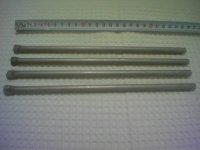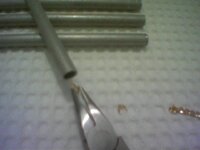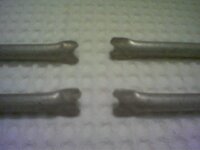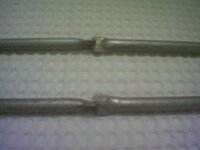digman
Full Member
- Jul 12, 2006
- 170
- 4
- Detector(s) used
- L-Rods & MineLab
- Primary Interest:
- All Treasure Hunting
This article is dedicated to Dowsers, to all those gifted from mother nature people who have the will and courage to discover literally anything hiden in earth.
My dowsing set consists of 4 rods and the construction is as simple as follows:
Material is hollow aluminum tube, the one usually found in television antenas. External diameter of tube should be around 8mm and length of each tube 24cm. So we cut 4 pcs of 24cm tube.
We press flat the one end of each rod. The flat part should be 1cm long (pic-01).
We insert inside each rod one small ring taken from a golden neck chain. If it does not fit, it can be pressed to the size of a rice, using plyers (pic-02). Care should be taken in order each small golden ring to move freely inside each rod.
Now comes the tricky part. We must take out the air from each rod. This can be done by holding the rod by the flat side, in vertical position with the small golden ring in the bottom of the tube. We turn slowly the rod in horizontal position and then, in order not to drop the insert, we turn it very very slowly downwards. Approximately 15 to 20 degrees is enough. We light a cigarette lighter and keep the flame just below the hole of the rod for 10 to 15 seconds time. Then, using a set of plyers, we press flat this end of the rod. Care should be taken that the small golden ring moves freely inside the rod.
We repeat the process to all 4 rods.
Using a file for metals, we file a small ’V’ on the one only side of each rod (pic-03).
The rods are ready. As simple as that!!
At this point I shall note that inside the rods we insert gold if we are searching for gold. We may insert silver if silver is searched, and so on. With gold inside we may detect old closed caves too, from long distance.
Two person, facing each other, are needed for the operation. Each person holds two rods, one rod in each hand, elbows to the side of the body.
Rods parallel to each other at about 10cm apart, in horizontal position, hands and rods in straight line. The ‘V’ towards the other person. To start searching, having our elbows to the side of the body, we lift up hands and rods in line, in order the golden insert to move towards our fingers. Now, both persons start lowering back hands and rods to the horizontal position (pic-04) in a straight line, our left ‘V’ should lock the right ‘V’ of the person faced and our right ‘V’ to lock to his left ‘V’. As soon as they will be leveled to horizontal, the ‘Vees’ will point towards the golden target. They have the ability to point up, down, left, right and sidewards. If you ask someone to hide home some golden jewelry, you will have your first succesful discovery. Initialy you find the direction and then while moving towards this direction you try again, untill you find it.
One gold coin may be found at 50 yards-meters away, depending on depth. A hiden cave can be pointed from 250 to 300 yards-meters away.
Practice is needed for holding the rods lightly while touching the oposite ‘Vees’.
Thats all.
Thank you all for reading this article, trust me, it works perfectly from the first try.
Digman.
My dowsing set consists of 4 rods and the construction is as simple as follows:
Material is hollow aluminum tube, the one usually found in television antenas. External diameter of tube should be around 8mm and length of each tube 24cm. So we cut 4 pcs of 24cm tube.
We press flat the one end of each rod. The flat part should be 1cm long (pic-01).
We insert inside each rod one small ring taken from a golden neck chain. If it does not fit, it can be pressed to the size of a rice, using plyers (pic-02). Care should be taken in order each small golden ring to move freely inside each rod.
Now comes the tricky part. We must take out the air from each rod. This can be done by holding the rod by the flat side, in vertical position with the small golden ring in the bottom of the tube. We turn slowly the rod in horizontal position and then, in order not to drop the insert, we turn it very very slowly downwards. Approximately 15 to 20 degrees is enough. We light a cigarette lighter and keep the flame just below the hole of the rod for 10 to 15 seconds time. Then, using a set of plyers, we press flat this end of the rod. Care should be taken that the small golden ring moves freely inside the rod.
We repeat the process to all 4 rods.
Using a file for metals, we file a small ’V’ on the one only side of each rod (pic-03).
The rods are ready. As simple as that!!
At this point I shall note that inside the rods we insert gold if we are searching for gold. We may insert silver if silver is searched, and so on. With gold inside we may detect old closed caves too, from long distance.
Two person, facing each other, are needed for the operation. Each person holds two rods, one rod in each hand, elbows to the side of the body.
Rods parallel to each other at about 10cm apart, in horizontal position, hands and rods in straight line. The ‘V’ towards the other person. To start searching, having our elbows to the side of the body, we lift up hands and rods in line, in order the golden insert to move towards our fingers. Now, both persons start lowering back hands and rods to the horizontal position (pic-04) in a straight line, our left ‘V’ should lock the right ‘V’ of the person faced and our right ‘V’ to lock to his left ‘V’. As soon as they will be leveled to horizontal, the ‘Vees’ will point towards the golden target. They have the ability to point up, down, left, right and sidewards. If you ask someone to hide home some golden jewelry, you will have your first succesful discovery. Initialy you find the direction and then while moving towards this direction you try again, untill you find it.
One gold coin may be found at 50 yards-meters away, depending on depth. A hiden cave can be pointed from 250 to 300 yards-meters away.
Practice is needed for holding the rods lightly while touching the oposite ‘Vees’.
Thats all.
Thank you all for reading this article, trust me, it works perfectly from the first try.
Digman.









